Of Sound Mind

Helianthus debilis, Family Compositae/Asteraceae (daisy/aster family). Also called beach sunflowers and cucumber-leafed sunflowers. These grow outside (and have ID labels at) our local library, whose grounds are xeriscaped.
A xeriscaped landscape conserves water and protects the environment. More info on the practice can be found at Greenbuilder.com.

According to Floridata.com, this flower is used for groundcover and dune stabilization. It is drought-tolerant, attractive to butterflies, and belongs to the same genus as the huge, upright annual sunflower, H. annuus.
Before today's treats of sight, Mary and I had walked through darkness to treats of sound....
We'd gone to the mall on Tuesday, followed by a jaunt to Home Depot. I'd met up with Mary at Radio Shack. She couldn't find what she was looking for, but I finally broke down and bought a digital recorder that fits in the palm of my hand -- and in my camera bag.
I'd been eyeing digital recorders for years, especially those that could upload files to my computer. I write my own notes longhand, in a journal notebook that travels everywhere with me. In the end my own dictation had not decided my purchase. What we were hearing on our walks had.
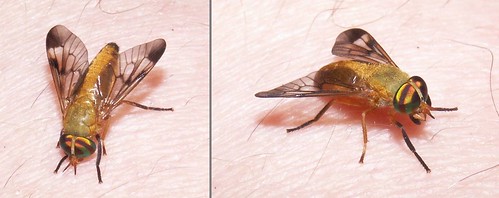
This yellow fly (Diachlorus ferrugatus, Family Tabanidae) had landed on my leg in Home Depot and surprisingly didn't bite, even though it comes from the same family as horse flies and deer flies. (Mary had known this was a biting fly because of its triangular-shaped wings.) Only the females bite -- and, according to the University of Florida, do so aggressively.
And quietly. There'd be no recording that one.
UF gives no guidance on how to tell male from female yellow flies, but says, "The female can be distinguished from deer flies by the very narrow frons (space between the eyes in front)," which this one seems to have. If it's a female, maybe she'd already enjoyed a blood meal, but that wouldn't explain why she kept dogging me down the aisle.
According to UF, this fly came to the United States by way of Mexico and has expanded out to the Bahamas, but has not yet been found elsewhere in the West Indies. "It is one of the few tabanids which attacks indoors. All exposed parts of the victim's body may be attacked, and since the flight is rather quiet, a person is not aware of the flies until the sharp pain of the bite is felt. Domestic animals, including dogs, are attacked readily, although the fly's preference for shade makes it less of a pest to cattle and horses in open pastures. Flies are on the wing in Florida from March to November, although the peak season is April through June."
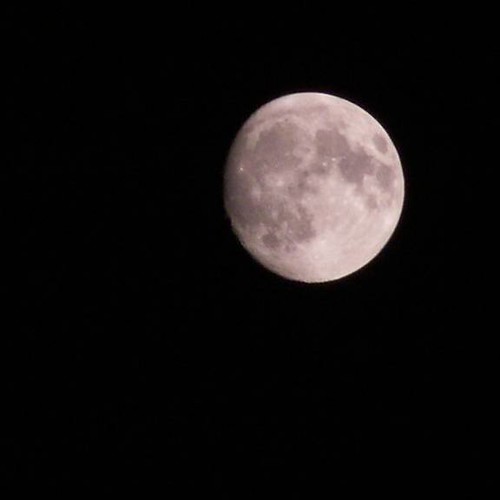
We took our "post office walk" on Wednesday night, beneath a moon 3 days short of full. We would head home by going out of our way, crossing the county road. That's where the forest lay, set back -- and within it the Chuck-Will's-Widows.
First, Mary wanted to check out the "post office pond," several blocks in the other direction. I wasn't in any hurry.
I've described the pond's frog chorus in this entry, but that had been back in August, not May. Although I did not hear any distinct calls of "Baby ... Baby ... Baby ..." on Wednesday night, the frogs sounded very much like what we'd heard last year.
The resulting .wav file (2 minutes, 1.3 MB) grows progressively louder as I ease down the grassy slope, toward the water, holding the recorder out at arm's length and unable to wipe the grin off my face. Behind me an occasional car tooled down one of our main residential roads, which we crossed before heading back to and across the county road.
We could hear the Chuck-Will's-Widows in the distance. My first attempt at recording them took me past an empty lot and up to a No Trespassing sign, still too close to traffic. Then I remembered the VFW building, located considerably closer to the forest. We turned down an empty road.
The VFW lot was empty save for a single car; through the window we could see a TV flickering. The nightjars were closer now. Mary sat by an outdoor table while I padded to the end of the asphalt and onto grass flattened from overflow parking.
There was no way I could see the birds in the dark. Holding the recorder before me like a dowsing rod, I set out to capture their call (a shade over 3 minutes, 2 MB), which grew in volume as I advanced until I stood still, my arm outstretched, listening at the edge of the property.
Back at the VFW the insects held a convention by the building's bright corner light.

I got my first look at this Skiff Moth (Prolimacodes badia, Family Limacodidae/Slug Caterpillar Moths). According to Bugguide.Net, this species ranges from New Hampshire to Florida and west to Missouri, Arkansas, and Mississippi. Like most slug caterpillars, it feeds on a wide variety of trees and plants: birches, blueberries, chestnut, hornbeams, oaks, poplars, willows, cherries, and others. Adults are attracted to lights. At first I wondered if I were looking at a sphinx moth, but that's a different family entirely. Bugguide's Bob Patterson provided the ID.
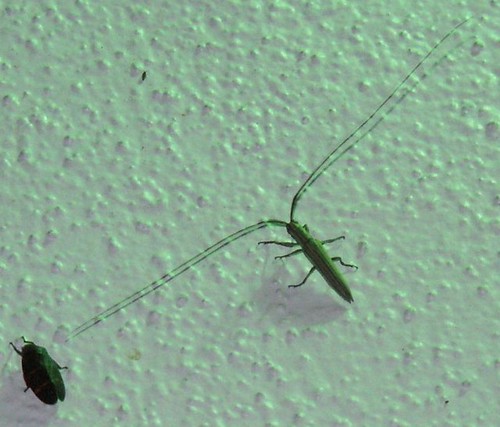
Thanks to Thingfish23's entry, Hippopsis lemniscata, I didn't have to look up this Longhorn Beetle. (Tf23 also has much better pictures of this species). I haven't yet identified the sidekick at lower left.
Mary and I continued home, stopping to pick up a few groceries at Winn-Dixie -- in whose retention pond a second, different chorus of frogs (41 seconds, 450K) serenaded us. Though not as melodic as the first group, these frogs were equally boisterous.

Winn-Dixie and the rest of the strip mall is up top. Down below, behind me relative to the market and almost invisible, lies the retention pond.
Earlier in the day, around the corner from the market, we'd caught a couple of lizards in flagrante delicto.
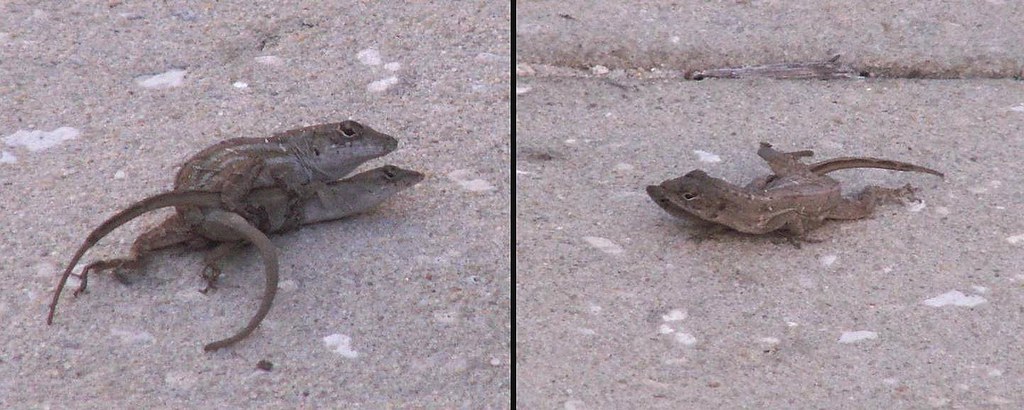
I used my telephoto on these shots, because to switch to macro and be up close and personal with the happy couple would be -- well, it would be rude.
It was getting on toward midnight by the time we arrived home. The clouds had cleared enough to offer a good view of both the Moon and Jupiter. I put my recorder away and grabbed the tripod.
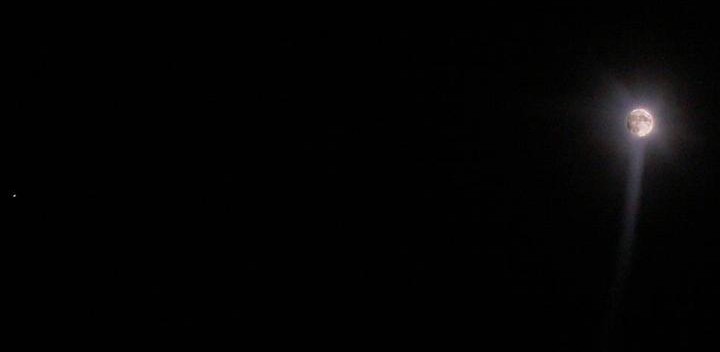
Jupiter is at center left. I had overexposed the first shot to get the planet to show, using a 1/3-second exposure at f/4.5. On that I overlaid the moon, photographed with a 1/250th-second exposure, also at f/4.5. (Jupiter was not visible in that second shot.)
As I photographed from our driveway I could hear the Chuck-Will's-Widows, still calling in the distance.











1 Comments:
Love the mandala...and if you just look at the pictures the bugs seem to be moon creatures!
Post a Comment
<< Home